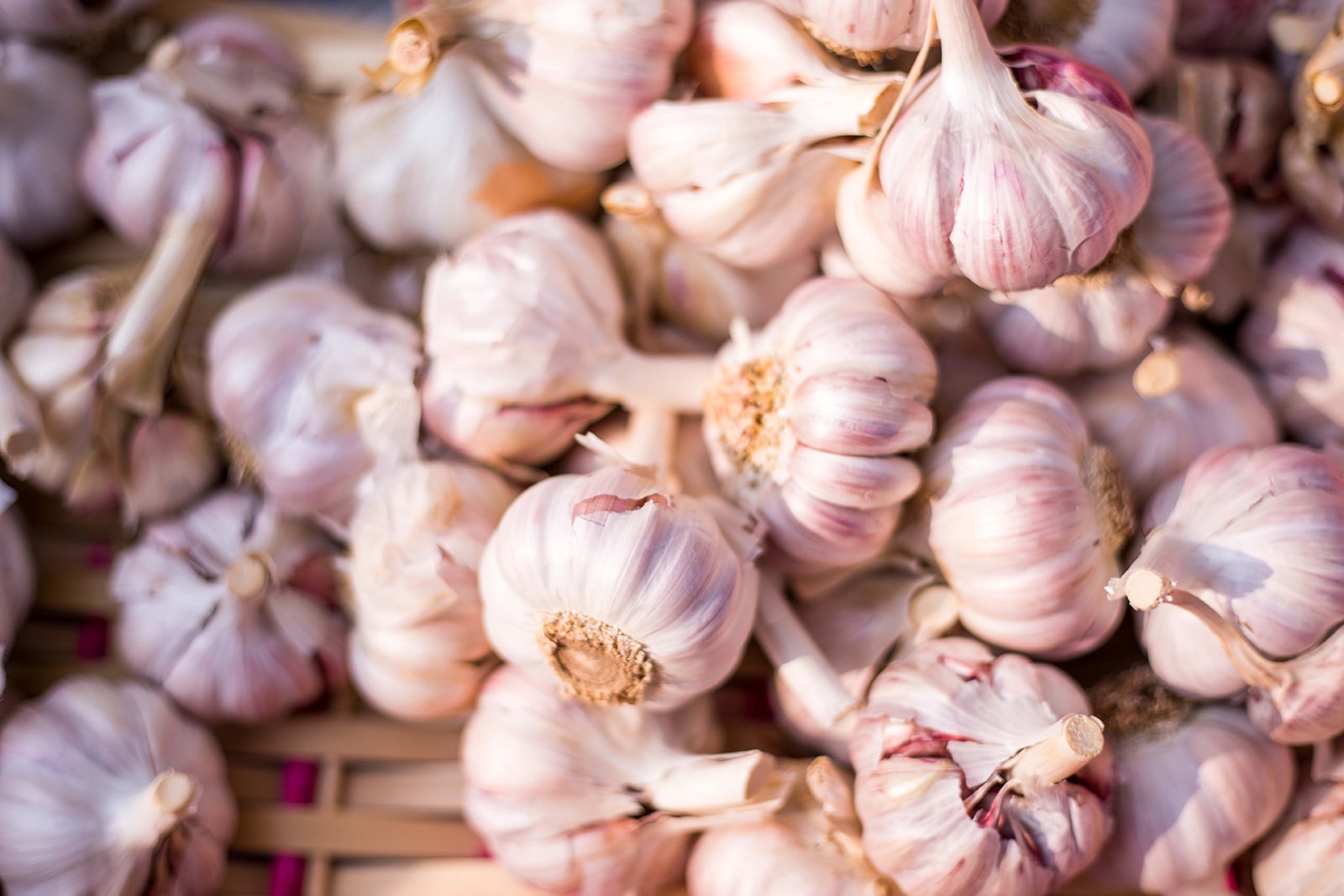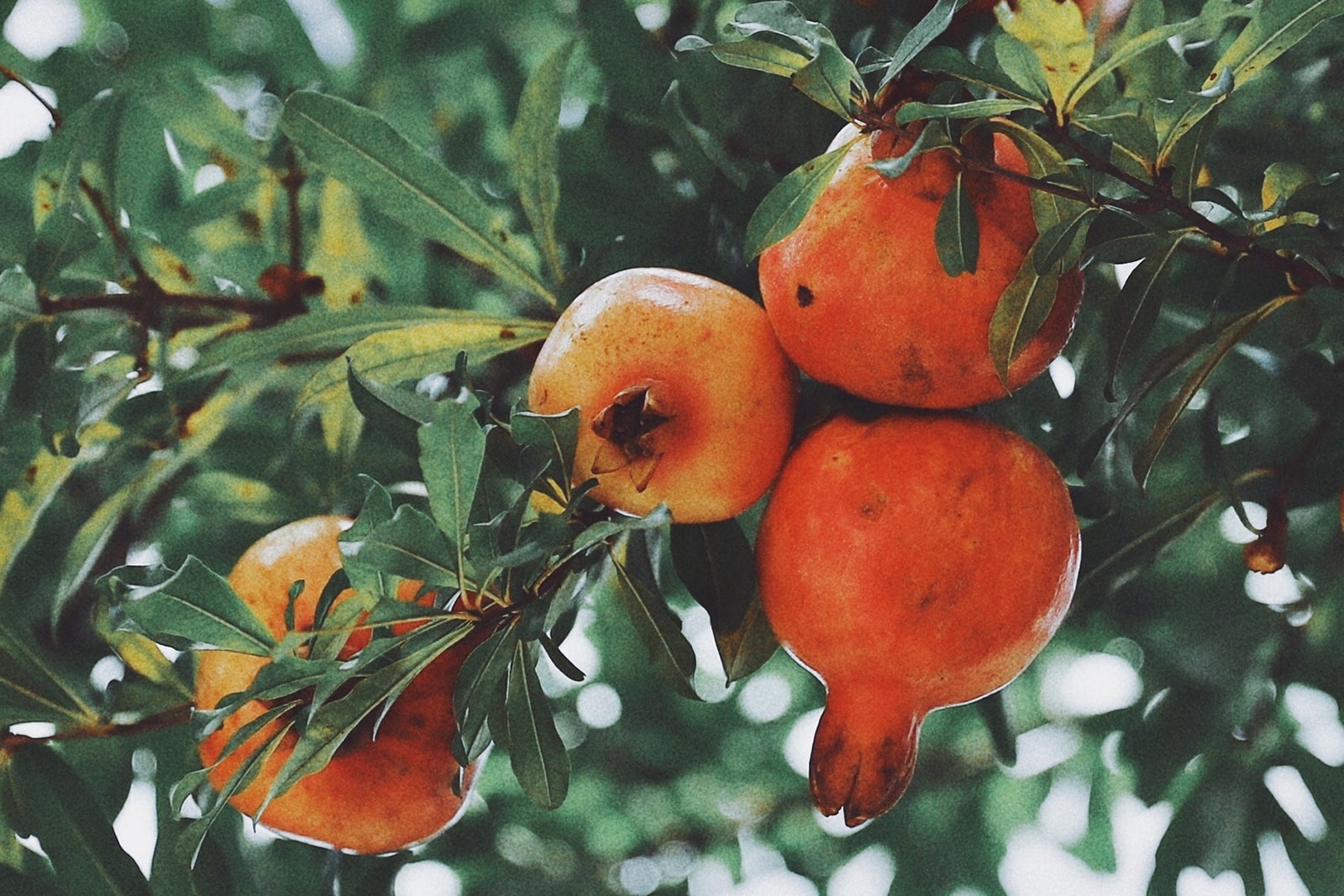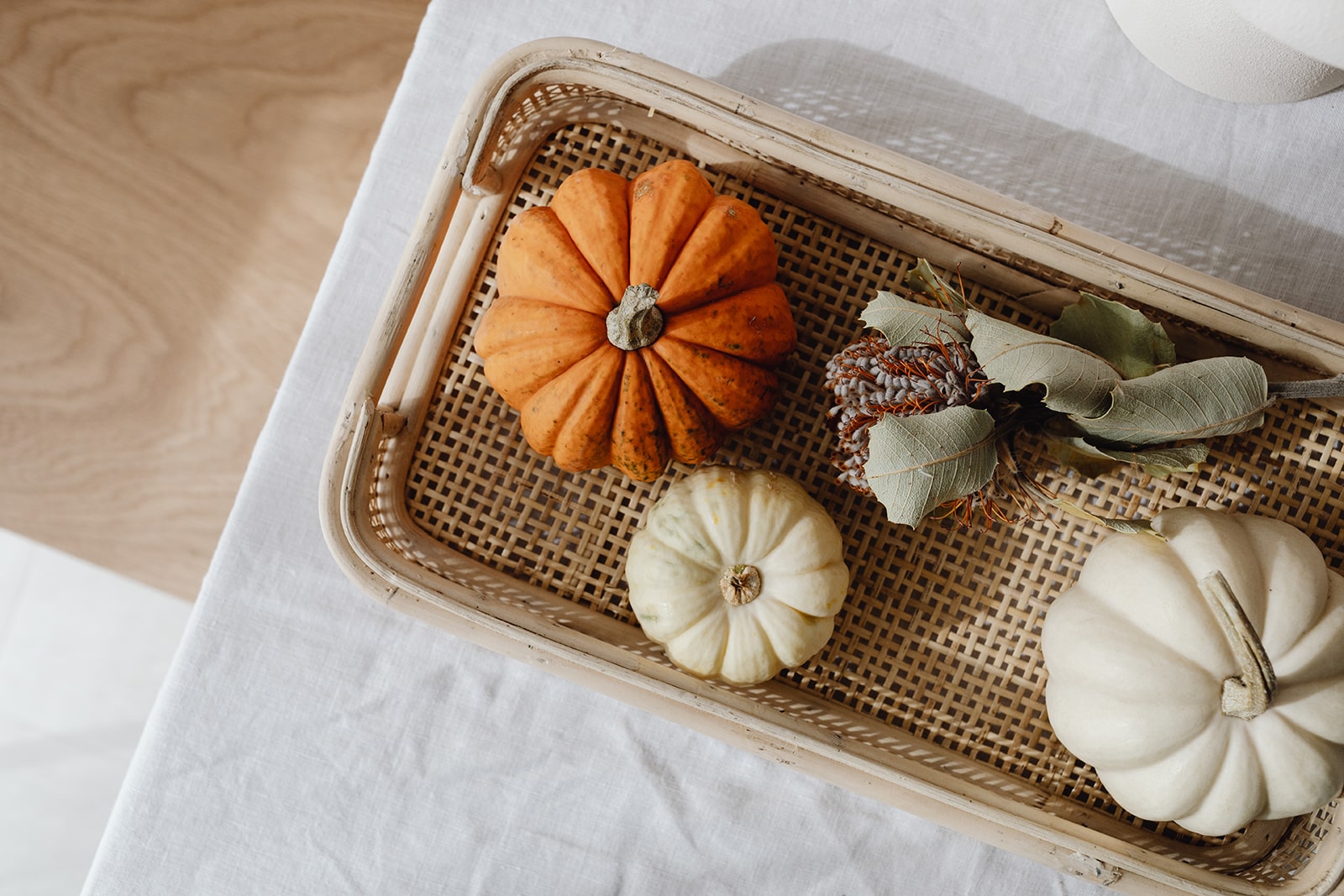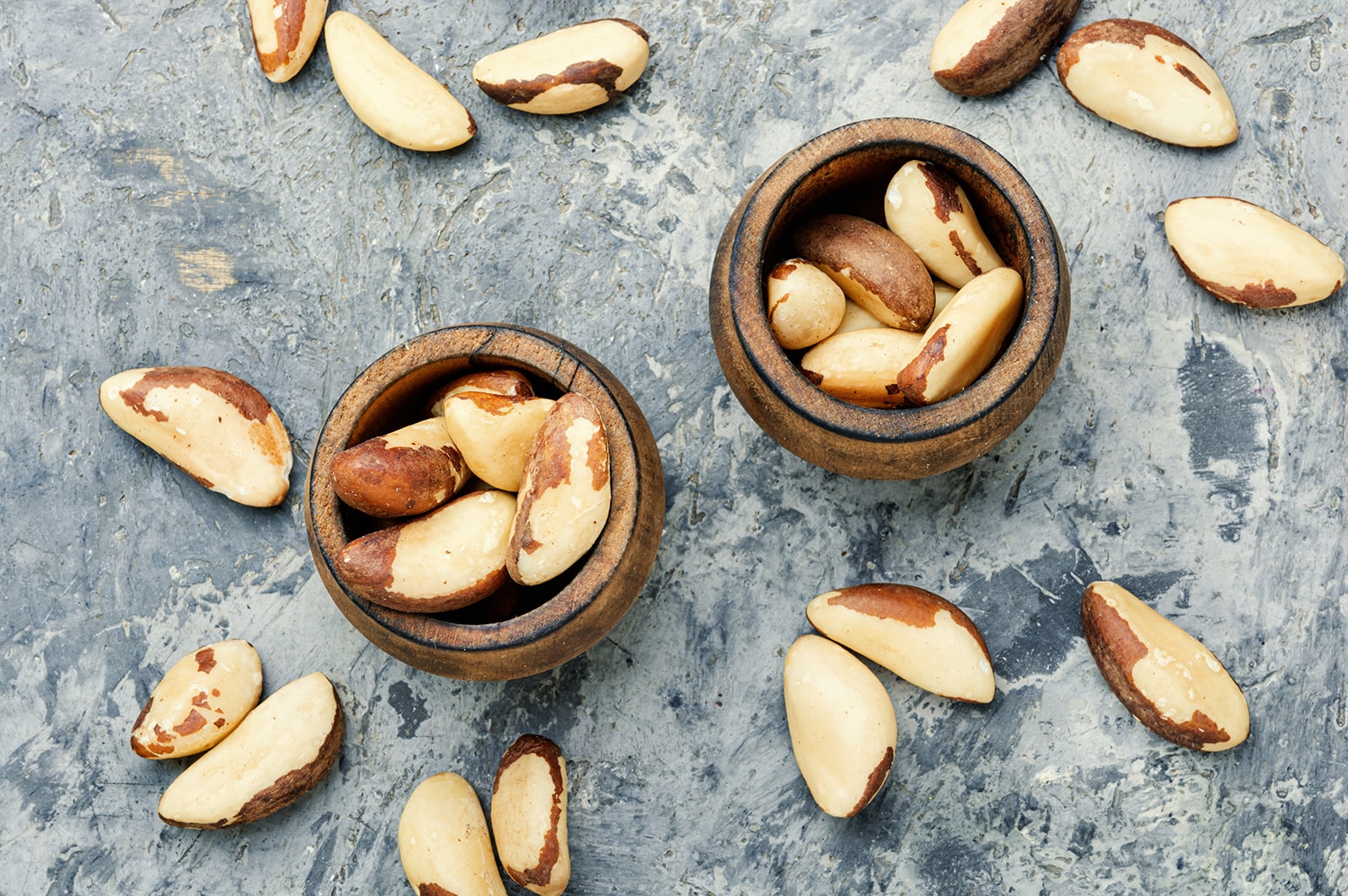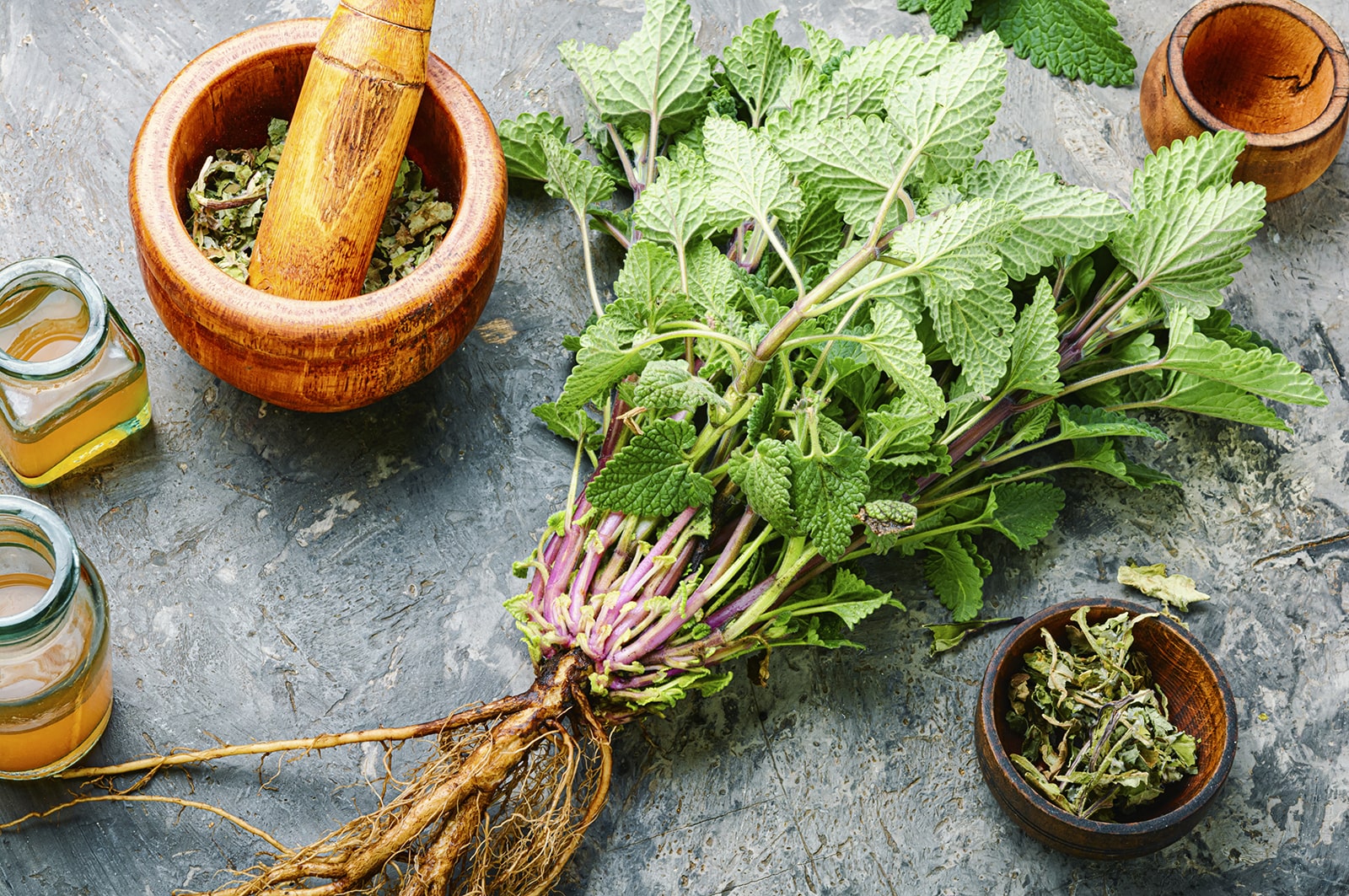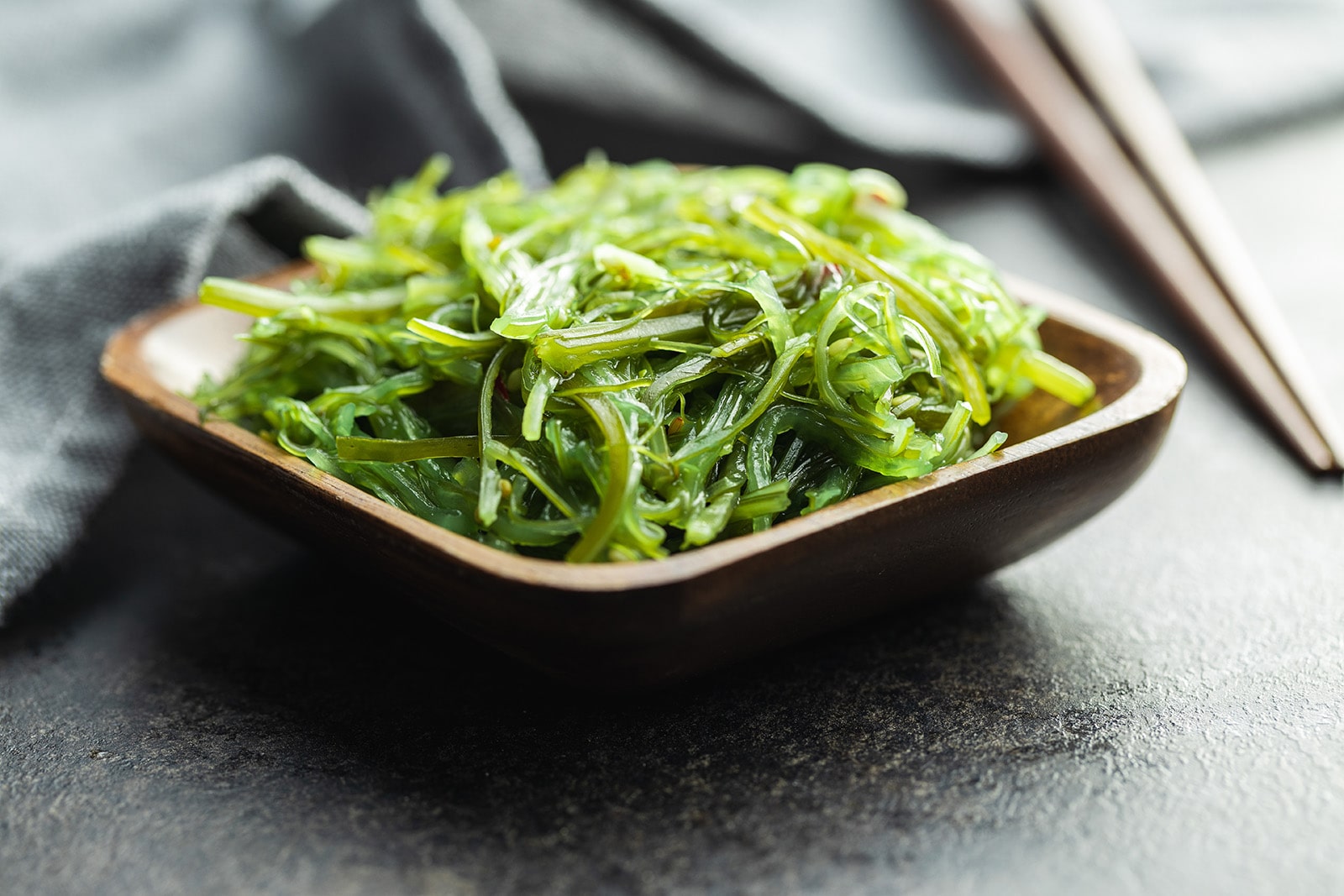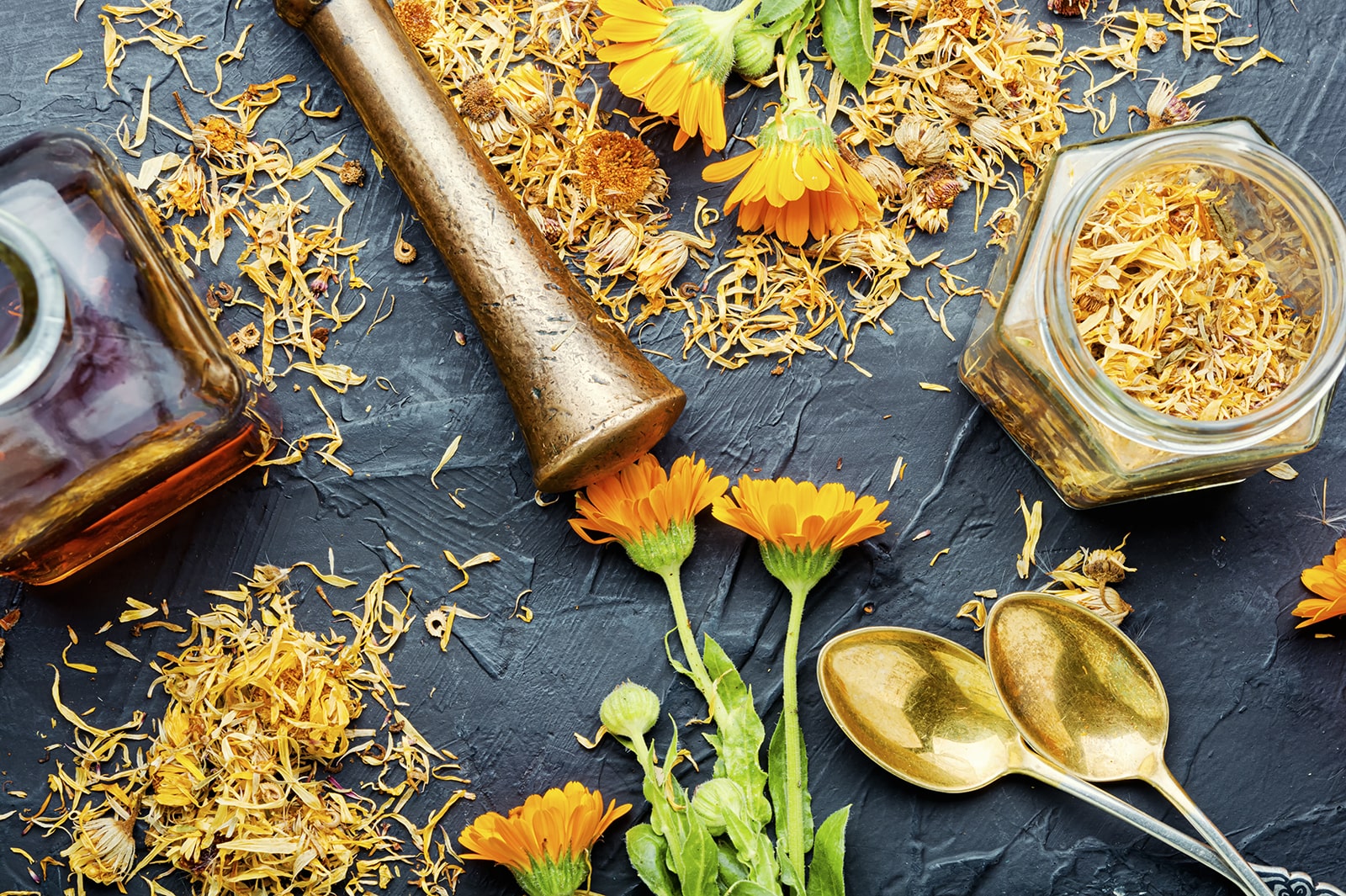Pomegranate Pear Salad
Pomegranate Pear Salad on a Bed of Spinach
I might be bias, but this is one of my favorite salad combinations. If you’re looking for a starter to a special dinner, or simply want to treat yourself to something a little festive, crunchy and sweet then this Pomegranate Pear Salad one is the one for you!
The mix of tart, sweet, and bitters is stimulates the taste buds while helping improve digestion for the bigger meal to come. The sour from the pomegranate and lemon help to boost stomach pH to prime it for digestion. The bitters from the greens help stimulate digestion. And the thyme used in the dressing is a well known carminative – helping reduce gas or bloating.
Pomegranate seeds add beautiful color against the dark leafy greens. You probably already know about what a powerhouse antioxidant the tangy-sweet pomegranate is. Then juicy strips of Bartlett pear provide a sweet balance to the radicchio.
The entire salad is complemented by the nutty crunch and a lemon-thyme based dressing. The result is super-nutritious and super-delicious!
Ingredients
- 3/4 cup unsweetened pomegranate juice
- 1 tablespoon fresh lemon juice
- 2 teaspoons roasted hazelnut oil or extra-virgin olive oil
- 1/2 teaspoon kosher salt
- 1/2 teaspoon minced fresh thyme leaves
- 1/8 teaspoon freshly ground black pepper
- 5 ounces spinach leaves
- 3/4 cup finely shredded radicchio (from 1 head)
- 1/2 cup pomegranate seeds*
- 1/2 cup coarsely chopped toasted hazelnuts
- 1 large firm-ripe Bartlett pear
Salad Preparation
- In a small saucepan, boil pomegranate juice until reduced to 1/4 cup, 5 to 6 minutes. Let cool. Whisk in lemon juice, oil, salt, thyme, and pepper.
- In a salad bowl, gently mix spinach, radicchio, pomegranate seeds, and hazelnuts with dressing. Divide among 6 plates.
- Quarter pear and core. Thinly slice crosswise, then stack slices and cut in matchsticks. Arrange pear on salads.
*Helpful Hints for Extracting Pomegranate Seeds: Cut a pomegranate into chunks. Put chunks in a bowl of water, and, working underwater, use your hands to break seeds free from pith.
OR try this this method: An Easy Way to Extract Pomegranate Seeds (video)
Garlic (Allium sativum)
Garlic (Allium sativum)
Fun fact: Garlic is an edible bulb from the lily family. Yup, as in the flower.
Garlic Allium sativum is affectionately known to herbalists as “the stinking rose.” for centuries, there has been many traditional medicine uses for garlic. Uses include treatment of skin conditions, immune support, antimicrobial, and even to reduce risk for cancer and heart disease. In fact, Garlic’s reputation is so strong in this area, it is one of the most widely studied herbal supplements for its beneficial effects on the heart.
Garlic contains several vitamins and minerals that support heart health, including vitamin B6, vitamin C, manganese, and selenium. But it’s the same chemicals that give garlic its pungent odor that scientists believe are the source of the herb’s heart health-promoting effects. Garlic is rich in the allicin, alliin, and ajoene—antioxidant compounds that help reduce the risk for cardiovascular disease.
There are three main health benefits of garlic that are strongly supported by science include:
- Slows the development of atherosclerosis (hardening of the arteries)
- Reduces blood pressure
- Reduces triglycerides and improves cholesterol
The amount of active compounds supplied by garlic supplements can vary because allicin is very sensitive to air and heat. For example, aging garlic to reduce its odor also reduces the allicin present and compromises the effectiveness of the product. So it’s interesting to note that studies on garlic and the cardiovascular system typically use garlic powder, oil, or aged extracts – not always when the antioxidants are the most potent.
Generally safe for most adults, taking a garlic supplement can cause heartburn, upset stomach, an allergic reaction, and breath and body odor (common with raw garlic). Garlic (especially in high doses) may impair the body’s ability to form blood clots should not be taken by persons who are preparing for surgery or who have bleeding disorders because it – ask your doctor if you’re on a blood thinner before you use a garlic supplement.
Let’s not skim over garlic’s antimicrobial properties – if you haven’t already check out my blog on using garlic to make “Fire Cider Vinegar” to help boost immunity in the winter. This stuff saved me last week when I was getting congested and run down.
Resources
- World’s Healthiest Foods: Garlic. http://www.whfoods.com/genpage.php?tname=foodspice&dbid=60
- National Center for Complementary and Integrative Health. Garlic. https://nccih.nih.gov/health/garlic/ataglance.htm
- Medline Plus. Herbs and Supplements: Garlic. (Includes information on garlic interactions with other drugs) https://www.nlm.nih.gov/medlineplus/druginfo/natural/300.html
- Karagodin VP, Sobenin IA, Orekhov AN. Antiatherosclerotic and Cardioprotective Effects of Time-Released Garlic Powder Pills. Curr Pharm Des. 2015 Nov 12. Available from: http://www.eurekaselect.com/136921/article
- Seki, T. and Hosono, T. Prevention of Cardiovascular Diseases by Garlic-Derived Sulfur Compounds. Jnl of Nutritional Science & Vitaminology (Tokyo). 2015. 61 Suppl:S83-85. doi: 10.3177/jnsv.61.S83. Date Accessed: Dec 8, 2015. https://www.jstage.jst.go.jp/article/jnsv/61/Supplement/61_S83/_pdf
- Xiong, XJ., Wang, PQ, et al., Garlic for hypertension: A systematic review and meta-analysis of randomized controlled trials. Phytomedicine. 2015 Mar 15;22(3):352-61. doi: 10.1016/j.phymed.2014.12.013. http://www.ncbi.nlm.nih.gov/pubmed/25837272
The Mighty Pomegranate (Punica granatum)
The Mighty Pomegranate (Punica granatum)
Growing up, pomegranate Punica granatum was one of my favorite winter fruits. It was always such a treat when my mom would hand me a bowl of bright red seeds!
Later on, when I had to peel my own pomegranate – let’s just say I ate less and less of it. Who wants to deal with that crazy mess?? And where do all those seeds go flying off too anyway?
Until I learned how to open one without making a mess… have you seen this video on how?
Inside a lumpy, thick-skinned pomegranate you’ll find a treasure of jewel-like arils-ruby seeds surrounded by sacs of flavorful juice. Pomegranate is both richly sweet and tart and exceptionally refreshing. Eat the arils (yup, that’s what they’re called, apparently!) by the spoonful, adding them to salads, oatmeal, or to Greek yogurt.
You’ll definitely want to check out this Pear and Pomegranate Salad recipe – it’s one of my favorites!
Pomegranate is native to the mountainous regions along the Caspian Sea, near northern Iraq and northwest Iran. For centuries, cultures around the world have used all parts of the tree—roots, bark, flowers, peel, seed and seed oil—medicinally to treat a range of health concerns, from digestive disorders and dysentery, to fever and heart ailments. Although in the West, the fruit and seed are typically used in medicinal preparations, you can make a tee using the peels and leaves quit easily.
Modern research indicates that pomegranate may be beneficial for reducing risk and supporting treatment for arthritis, certain types of cancers, erectile dysfunction, and heart disease. An antioxident compound only found in pomegranates called punicalagin is responsible for the beneficial effects to the heart and blood vessels. In fact, pomegranate has more antioxidant power than red wine and green tea!
Preliminary research shows that drinking unsweetened pomegranate juice helps improve cholesterol, lower blood pressure, improve blood flow to the heart, and may help protect against the formation of blockages in the arteries. The research is not clear how much pomegranate juice (or as a nutritional supplement) is beneficial for different people and for different health concerns.
When buying pomegranate, don’t shy away from a fruit that isn’t perfectly round or feels heavy. Unusual shape, and weight indicate a fruit that is plump with arils and juice. Pomegranates do not sweeten once picked, so you’ll want to avoid fruits that look dried out.
Resources
- Johnson, Rebecca L. & Foster, Steven et al., National Geographic Guide to Medicinal Herbs: The World’s Most Effective Healing Plants. (National Geographic Society. (2010, 2014), 249-251.
- Swanson, H. Super Natural Cooking: Five Ways to Incorporate Whole and Natural Ingredients Into Your Cooking. (2007), 80. Ten Speed Press: Berkeley, CA.
- Pomegranates and Health. (Recipes and other Resources) http://pomegranates.org/index.php?c=3
- Medline Plus. Pomegranate. https://www.nlm.nih.gov/medlineplus/druginfo/natural/392.html
- National Center for Complementary and Integrative Health. Pomegranate. https://nccih.nih.gov/health/pomegranate/at-a-glance
- Basu, A., Penugonda, K. “Pomegranate juice: a heart-healthy fruit juice.” Nutr Rev. (2009) Jan: 67(1):49-56. doi: 10.1111/j.1753-4887.2008.00133.x. Accessed on: Dec 8, 2015. http://www.medicatrix.be/download/grenade_protecteur_cardiovasculaire.pdf
- Stowe, C.B., “The effects of pomegranate juice consumption on blood pressure and cardiovascular health.” Complement Ther Clinical Pract., (2011, May), 17(2):113-5. doi: 10.1016/j.ctcp.2010.09.004. Available from: http://www.ctcpjournal.com/article/S1744-3881(10)00076-9/abstract
- Sumner Michael D., Elliot-Eller, M. et al., “Effects of Pomegranate Juice Consumption on Myocardial Perfusion in Patients With Coronary Heart Disease.”: Amer Jnl of Cardiology. (2005) 810-814. Date Accessed: Dec 08, 2015: http://www.ornishspectrum.com/wp-content/uploads/Effects-of-Pomegranate-Juice-Consumption-on-Myocardial.pdf
- Seeram NP, Aviram M, Zhang Y, et al., “Comparison of antioxidant potency of commonly consumed polyphenol-rich beverages in the United States.” J Agric Food Chem (2008), 56:1415-1422. Accessed on Dec 08, 2015: http://www.pubfacts.com/detail/18220345/Comparison-of-antioxidant-potency-of-commonly-consumed-polyphenol-rich-beverages-in-the-United-State
- Aviram M, Rosenblat M, Gaitini D, et al. “Pomegranate juice consumption for 3 years by patients with carotid artery stenosis reduces common carotid intima-media thickness, blood pressure and LDL oxidation.” Clin Nutr (2004). 23(3):423-33. Date Accessed: Dec 08, 2015: http://www.wonderfulpomegranateresearch.com/media/pdf/health/HH_2004_Aviram_ClinNutr_PJ_Consump_3Years_Carotid_021.pdf
Nutrition Labels Made Easy
Truth time.
I’m old enough to remember when there wasn’t a mandatory food label. It was a time of much confusion. We didn’t always know how many calories we were eating, or how many sugar alcohols we consumed. It was a dark time in history.
In all seriousness, the food label was one of those things that made sense. When it became a mandatory thing, and pretty much everyone was like, “YEAH! That’s a good idea. Why didn’t we do this sooner?”
The problem is, 25 years later, it’s still not perfect. Frankly, sometimes the label isn’t completely clear and can be misleading (most notably when it comes to serving size). Most importantly, many people still don’t really know how to use it to guide their food choices.
When you are cruising the grocery aisles, how often do you flip over your items to check out the nutrition labels or ingredients? I hope so! But let’s do a little review:
There are actually changes from the FDA in the pipeline aimed at updating the label to better reflect current concerns including more realistic serving sizes. Until then, use this as quick guide to help you make more informed food choices:
Nutrition information is provided for one serving of a food or beverage.
How often do you limit yourself to a ½ cup of ice cream when you’re catching up on your Netflix queue? Doesn’t seem like enough to get you through a whole episode of OITNB or Game of Thrones, but that’s a serving size. A pint of Ben and Jerry’s is actually meant for multiple servings; four, in fact.
If a serving size is a ½ cup, and you eat 1 cup, then you must double the calories, fat, sugar, and other ingredients to get an accurate estimate of how much you’ve actually eaten. So if you eat the whole pint (four servings, so you’d have to multiply by 4)… I’ll let you do the math.
Pay special attention to the amount of sugars (including carbohydrates) in one serving.
This is especially important if you have diabetes (or other health concerns) that require you to monitor sugar intake or the glycemic index of foods. At the same time, look for hidden sources of sugar or artificial sugars in the ingredients (like high fructose corn syrup, stevia, or saccharine) which can actually cause fluctuations in insulin response but don’t reflect in the carbohydrate/sugar count on the label.
Check out the amount of fat, especially saturated fat, in one serving.
Don’t get me wrong, some fats are good for you. But some fats contribute to chronic health problems. Saturated fat and trans fats are two examples of fats known to contribute to inflammation and bad cholesterol, which may lead to heart disease (among other problems). Minimize consumption of these fats, and opt instead to get more of your fats from better sources like nuts, seeds, olive oil, and avocados.
Be aware that “0” does not mean zero!
Did you know that a label can claim to be “Zero Trans Fats” but still have up to 1 gram of trans fat per serving?
For my math geek friends out there, I’m with you. This math is ridiculous. But in the food industry 0 simply means less than 5% per serving. This becomes a bigger issue when you consume multiple servings and it starts to add up.
In addition to the nutrition label, you want to take a look at the list of ingredients.
A good rule of thumb to follow: if you cannot pronounce the words that are listed in the ingredients, it’s likely a chemical worth avoiding. Now that’s not always the case. For example, I’ve seen foods fortified with vitamins and those names can be long and sinister sounding. But as Michael Pollen says, eat foods as close to their natural state as possible. The less processed, the simpler the ingredient list, the better.
Some of the items you want to avoid include:
- Preservatives including BHA, BHT, brominated products (that last one is part of a future post on thyroid)
- Genetically Modified Organisms (GMO), common in corn and soy derivatives. They won’t come out and say “these are GMO.” You can avoid these all together or look for organic and non-GMO verified on the label.
- Dextrose
- Xanthan gum
- Hydrocarbons (pesticides PCB, DDE, DDT)
- Soy and cottonseed oil
- Dyes (e.g., yellow dye no. 5, tartrazine)
- Monosodium Glutamate (MSG), common in canned foods and Asian cooking
- Food allergens in case you or family members have a known allergy or sensitivities to peanuts, wheat, dairy, soy, or gluten etc…
In a hurry? No time to read labels?
Simple fix, avoid packaged (bag, box, or bottle) foods. Instead, stick to fresh, whole, colorful foods (e.g., fruits, veggies, nuts, seeds). Many grocery stores now have ready-made options like quinoa, bean salad, and grilled veggies and protein. There’re also many restaurants popping up with fresh, real ingredients for people on the go. And don’t forget to avoid drinking your calories and sugar- choose water, unsweetened green or herbal tea, or fresh veggie juices.
And finally – get involved!
In July of 2015 the government proposed a new nutrition information panel for food labeling. The public is invited to comment, so here’s your chance. It’s your health, don’t leave up to the feds alone. Whole you’re at it, make sure to voice your concerns about GMO labeling: http://www.fda.gov/Food/GuidanceRegulation/GuidanceDocumentsRegulatoryInformation/LabelingNutrition/ucm387533.htm
Fall Favorite: Pumpkin
Fall Favorite: Pumpkin
Though you might automatically think of lattes and Jack-o-lanterns, it’s in fact a seasonal favorite with more weight than just cultural tradition. Pumpkin is also also a nutritional powerhouse!
The orange squash is woven into the fabric of history and cuisine. It’s mentioned in literature, including Shakespeare’s reference to “pumpion” in The Merry Wives of Windsor and The Legend of Sleepy Hollow.
Native Americans roasted long strips of pumpkin over an open flame and ate them.
Colonists made pumpkin pie by slicing off the pumpkin top; removing the seeds; filling the rind with milk, spices, and honey; and then baking the pumpkin over hot ashes.
Pumpkin seeds are dried and salted to make a tasty snack.
And of course we can’t forget that the vibrant fruit (yes it’s a fruit! weird since we typically think of squash as a vegetable) is of course a staple in the Halloween decor department.
So in honor of October and pumpkin everything season, we’ll learn more about this seasonal favorite and the abundance of nutrients and its versatility in healthy meal preparation.
All About Pumpkin
A member of the Cucurbitaceae family (along with cucumber and squash), pumpkin is cultivated around the world for both its fleshy vibrant orange meat and seeds. It is a naturally low calorie (49 calories per one cup serving), yet full of filling fiber.
Health Benefits
- Pumpkin contains no saturated fats or cholesterol. It is rich in dietary fiber, antioxidants, minerals, and many antioxidant vitamins, including A, C, and E.
- It is also an excellent source of many natural polyphenolic flavonoid compounds such as beta-carotenes (which convert into vitamin A when activated in the body), lutein, and zeaxanthin (a natural antioxidant that may offer protection from age-related macular disease).
- Pumpkin is a good source of the B-complex group of vitamins including niacin, vitamin B-6 (pyridoxine), thiamin, and pantothenic acid.
- It is a rich source of copper, calcium, potassium, and phosphorus.
- Practically the whole fruit is edible. Pumpkin seeds provide dietary fiber and pack a powerful mix of protein, minerals, and vitamins: 100 g (1 cup) of pumpkin seeds provide 559 calories, 30 g of protein, plus folate, iron, niacin, selenium, and zinc.
Spiced Pumpkin Bread
Adapted from Bon Appétit Fast, Easy and Fresh cookbook
Yield: 2 loaves (cut ingredients in half for 1 loaf)
Preheat oven to 350°F
Butter and flour two 9x5x3 inch loaf pans
Ingredients:
- 1½ c. all-purpose flour (or gluten-free flour mix)
- 1½ c. whole wheat flour (or gluten-free flour mix)
- 1 tsp ground cloves
- 1 tsp ground cinnamon
- 1 tsp ground nutmeg
- 1 tsp baking soda
- ½ tsp salt
- ½ tsp baking powder
- 2 c. raw sugar (or raw honey)
- 1 c. sunflower oil
- 3 large eggs (room temp)
- 15 oz. (1 can) pure pumpkin (watch out for added sugar)
- 1 c. chopped walnuts (optional)
Directions:
Sift first eight ingredients into a large bowl. In second bowl, beat sugar and oil to blend, and then add eggs and pumpkin. Mix well. Stir dry ingredients into pumpkin mixture in two additions, just until blended. Add nuts, if you’re feeling nutty!
Divide between loaf pans. Bake approximately 1 hour 10 minutes, or until tester inserted into center comes out clean. Transfer to racks and cool in pans for 10 minutes. Cut around sides of pan with a knife to loosen. Turn loaves onto rack to cool, serve and enjoy!
Brazil Nut Butter Recipe
Brazil Nuts
Brazil nuts are calorie and nutrient dense. High in mono- and polyunsaturated fats, including omega-6 fatty acids, a one-ounce (6-7 nuts) serving provides about 185 calories, 5 grams of protein, and a rich supply of magnesium, phosphorous, potassium, and selenium. In fact, Brazil nuts are the highest natural source of selenium (543 mcg in 1 oz.).
A potent micronutrient, scientific evidence to date suggests that selenium might play a role in the prevention or treatment of heart disease, cognitive decline, liver disease, some types of cancer, and thyroid disease. Selenium concentrations are highest in the thyroid gland, and it has a vital role in its function.
Just two Brazil nuts a day make it easy for most people to meet their daily selenium requirement. But it’s important to work with a clinical nutritionist to assess your individual need for selenium if you suspect a deficiency to ensure you’re getting the right amount.
Because it is possible to get too much selenium, The Institute of Medicine of the National Academy of Sciences advises a maximum limit of 45 mcg of selenium for kids and 400 mcg for adults daily. The best way to enjoy Brazil nuts is to combine a few with other types of nuts, seeds, and raisins. Sprinkle on salad, yogurt, or blend into a smoothie.
Brazil Nut Butter Recipe
Homemade nut butters is a great opportunity to enjoy these nutritious spreads without added sugar, salt, or preservatives often found in store-bought varieties.
Note: There is a 2 to 1 ratio of nuts to nut butter. To make 1 cup of nut butter, start with 2 cups of shelled nuts.
Ingredients:
- 2 cups organic raw nuts (feel free to mix it up, equal parts brazil, almond and cashew for example)
- Optional flavor add-ins (all to taste; opt for organic or locally sourced):
- Salt
- Stevia, local, raw honey, or grade A/B maple syrup
- Vanilla or almond extract
- Cocoa powder or cacao nibs*
- Puree of dried fruit or dried fruit bits* (apricot, raisin, cherry, cranberry)
*The former creates a smooth spread, the latter chunky.
Prep:
To make the nuts more digestible, soak and dehydrate the nuts to extract phytic acids (compounds that bind minerals). Before grinding, soak nuts in water and cover for 8-12 hours. Dehydrate about 10 hours.
(optional) To add a distinctive, warm flavor, toast the nuts before grinding. Toast nuts on a dry baking sheet at 400°F until nuts are fragrant and lightly browned, 5 to 10 minutes. Watch closely; nuts easily scorch. Nuts should be cool to the touch before grinding.
Equipment:
Food processor or high-speed blender (e.g., Vitamix).
Directions:
Place nuts into a food processor and start blending, leaving out the optional flavor add-ins. Blend for 11-12 minutes. You may need to grind at various speeds or intervals until you reach the consistency that meets your taste preferences. The nuts will go through several stages and you’ll need to keep pressing the contents into the center of the blender as you go through the process: The nuts will crumble, clump, ball, redistribute, and then finally … the oils will release, and you’ll have a nice spread.
Mix in your choice of flavor add-ins by hand. Nut butter keeps in the refrigerator for about a month.
Resources
- National Institutes of Health. “Selenium: Dietary Supplement Fact Sheet.” Accessed May 2015.
- National Institutes of Health. “Selenium: Fact Sheet for Consumers.” Accessed May 2015.
- Nutrition and You. “Brazil Nuts Nutrition Facts.” Accessed May 2015.
- Anton Health and Nutrition. “Homemade Nut Butter.“
- Radiant Life Company. “That’s Nuts! A Complete Guide to Soaking Nuts and Seeds.”
Healthy Hair, Skin, and Nails
Healthy Hair, Skin, and Nails: A Nutritional Approach
The condition of your hair, skin, and nails (AKA the integumentary system) are a reflection of your overall state of health. For example, they can be a diagnostic symptom when diagnosing thyroid deficiency since they share similar nutritional requirements. Aside from the aesthetic appeal, having thicker hair, stronger nails and bright, clear skin may actually be a sign that vitamin levels are sufficient for optimal biological function.
A variety of factors can affect their condition, including genetics, exposure to tobacco smoke, sun damage, medication and drug use, and of course, nutritional deficiencies. While eating a well-balanced diet is the best way to keep the integumentary system healthy, sometimes vitamins can be a helpful insurance policy. Vitamin supplementation can replenish depleted vitamin stores and support the biological processes that boost growth of hair, skin and nails while simultaneously helping to tame the symptoms of hypothyroidism.
Honestly, vitamin formulas for healthy hair, skin, and nails contain many of the same nutrients that your entire body needs for growth and maintenance of cells. That’s because if your body is deficient in key nutrients needed for biological function, it is reflected in poor the integumentary system health (weak nails, brittle hair, and dull skin, for example). When addressing Hair, skin, and nails specifically, we’re look at vitamins that support keratin production- a protein essential as a building block for the integumentary system- as well as supporting repair and regeneration of new cells.
Biotin & the mighty B vitamins
The B-complex (B12, B3, and B6) are vital for dozens of biological reactions, including for hair and skin growth. Biotin, also a B vitamin, is sometimes used to help reduce or prevent hair loss. Some people do not get enough biotin in their diet, resulting in a systemic deficiency. In such cases, research has shown taking biotin supplements may help alleviate hair thinning. Biotin-rich foods include peanut butter, eggs, avocados, legumes, and bananas.
Vitamin D
Vitamin D is important for hair follicle cycling. A large portion of the population reports low supoptimal vitamin D due to reduced sun exposure, use of sun block, reduced intake of certain Vit D rich foods, and geographical location (i.e. individuals who live in northern parts of the United States where sunlight is limited). Click here to read my blog on supplements, including vitamin D. Salmon, mushrooms, beef liver, and grains are great food sources of vitamin D.
Zinc
Zinc is a key trace mineral for hair growth, wound healing, healthy skin, and immune function. People who are under high stress, fighting chronic infection, elevated toxic load, sluggish thyroid or adrenal fatigue are at greater risk for zinc deficiency. Zinc-rich foods include red meat, oysters, lamb, turkey, pumpkin seeds, and chocolate.
Vitamins C
Vitamins C is a powerful water soluble antioxidant, helping reduce DNA and cellular damage and increase cell turnover (boosting growth!). It’s also a necessary component in collagen formation helping improve skin elasticity for more youthful appearance. Vitamin C rich foods include citrus fruits, strawberries, mango, broccoli, kale and bell peppers.
Vitamin E
Vitamins E is a powerful fat soluble antioxidant. Research has shown that it plays a major role in protecting cells from damage and supporting cellular regeneration- both of the integumentary system as well as for cardiovascular health. Good sources are seeds, dark green veggies, safflower oil, and citrus fruits.
Essential Fatty Acids
Omega-3 and omega-6 fats have been shown to reduce inflammation and support skin and scalp health. You can obtain essential fatty acids from eating cold-water fish such as mackerel, salmon, sardines, anchovies, tuna, pollock, or shrimp. However, these fish can contain high levels of heavy metals—which in turn can deplete your zinc stores (among other physiological stressors). Follow these guidelines for safer consumption. If you are averse to eating fish, or are vegan, flaxseed oil or algae oil are great alternatives.
Horsetail (Equisetum telmateia)
Horsetail is an herb with antibacterial properties as well as remineralizing effect. It is rich in flavonoids, potassium, and silicon, which are vital to the functioning of rapidly growing tissues such as skin and nails. It also has a key role in the synthesis of collagen.
Resources
- National Institutes of Health. Vitamin and Minerals Supplement Fact Sheets. Accessed May 2015.
- Szyszkowska, B., et al. “The Influence of Selected Ingredients of Dietary Supplements on Skin Condition.” Postȩpy Dermatologii i Alergologii 31, no. 3 (June 2014): 174–181.
Lemon Balm (Melissa Officinalis)
Lemon Balm (Melissa Officinalis)
Native to Europe, lemon balm is grown all over the world. It is found in backyard herb gardens, in crops grown for medicine and cosmetics, and is used to scent candles and furniture polish. In the spring and summer, the flowers grow where the leaves meet the stem. If you rub your fingers on these leaves, your fingers will smell tart and sweet, like lemons. The leaves are similar in shape to mint leaves, and come from the same plant family.
As far back as the Middle Ages, lemon balm was used to soothe tension, to dress wounds, and to treat ailments such as toothaches, skin irritations, and sickness during pregnancy. As a medicinal plant, lemon balm is considered a calming herb that has traditionally been used to soothe menstrual cramps, reduce stress and anxiety, promote restful sleep, and ease gastrointestinal complaints (e.g., indigestion, gas, bloating, and colic). It is often combined with other herbs in teas or tinctures for relaxation, such as valerian and chamomile. Having trouble sleeping? Most research on lemon balm has shown that, when added to some sleep hygiene modifications, can be very beneficial for reducing insomnia.
In Europe, lemon balm has been used for treating thyroid problems and has shown an ability to regulate thyroid hormone production. It has been used in the U.S. as a complementary treatment for Graves’ disease, an autoimmune condition in which the thyroid gland is overactive.
Lemon balm may be formulated as a tea, tincture, or cream/ointment. Herbs do interact with other medicines and should not be taken without consulting your wellness practitioner for appropriate dosing.
Resources
- Restorative Medicine. Database Search: Lemon Balm and Thyroid Disease.
- University of Maryland Medical Center. “Hyperthyroidism.” Reviewed April 4, 2012.
- General Herb Information, The Herb Society of America. “Guide to Lemon Balm.”
- University of Maryland Medical Center. “Lemon Balm.”
Optimizing Thyroid Function
Optimizing Thyroid Function
It might be tiny, but thyroid gland is powerful! According to the American Thyroid Association, an estimated 20 million Americans have some form of thyroid disease. What’s even more staggering, is that up to 60% of those with a thyroid condition are unaware of it!
Located just below your Adam’s apple, in the middle of the lower neck, is a butterfly shaped gland responsible for the regulation of your inner state of balance (also referred to as homeostasis). There are generally three categories of malfunction: Hyperthyroidism, hypothyroidism, and autoimmune disease. The effects of malfunctioning (either over or under active) thyroid can manifest in various ways:
- Sluggishness, fatigue and difficulty getting things done
- Weight gain
- Difficulty concentrating
- Elevated LDL (that’s the bad cholesterol)
- Irritability, anxiety, and/or rapid heart beat
Let’s take a minute to find out more about what the thyroid does, how to know if there’s a problem, and most importantly optimizing thyroid function.
Thyroid Function Overview
The thyroid is part of the endocrine system, which includes the pituitary gland, hypothalamus, thymus, pineal gland, testes, ovaries, adrenal glands, parathyroid, and pancreas. It makes hormones, primarily T3 and T4 but has effects on production of other hormones as well. Hormones travel through your bloodstream and regulate your metabolism, brain and heart function, and reproductive and menstrual cycles.
When the thyroid is not functioning properly, a chain reaction of hormonal events takes place that involves many other glands/hormones of the endocrine system and the bodily systems they regulate. The end result is one of two primary types of health conditions: hyperthyroidism or hypothyroidism. (Autoimmune disease often results in either hypo- or hyper- function)
Hyperthyroidism results when the thyroid is overactive. Think of hyperthyroidism like a butterfly that can’t stop fluttering its wings. Everything is on overdrive, including metabolism, frequency of bowels, emotions (anxiousness), increased sweating, and for women, very light menstruation or cessation of the menstrual cycle. Symptoms often include feeling hot and difficulty maintaining a healthy weight. There are also bouts of exhaustion from trying to maintain this intense state of arousal and it often puts the adrenal glands on overdrive.
Hypothyroidism results when the thyroid is underactive. This is more common condition of the two. In this case, the butterfly just can’t get its wings to get going. Weight gained, sluggishness, and brittle hair and nails are very common symptoms. These are also often accompanied by feeling cold and tired, depressed, and often suffering from constipation. Menstruation for women with hypothyroidism is often irregular and heavy.
5 Ways for Optimizing Thyroid Function Naturally
- Eat from the sea. The sea provides many natural sources of iodine, a building block of the thyroid hormone. Table salt has a high concentration of iodine because it’s been fortified, but it can also raise blood pressure. Sea salt is also a good source of natural iodine, but should also be used sparingly if you are having water retention issues or concerned about hypertension. Instead, you may choose to opt for saltwater fish, or seaweed. Cod and halibut are high in selenium, which protects the thyroid gland during periods of stress and helps regulate hormone synthesis. Fish oil provides essential fatty acids that reduce inflammation, which plays a role in causing autoimmune diseases.
- Eat from the earth. Eat foods high in B vitamins, which are precursors to thyroid hormones and influence cell energy. Balance your diet with poultry, nuts and seeds, legumes, and whole grains (avoid refined grains* like bread and cereals). Red meat provides iron, zinc, magnesium, and other minerals essential for thyroid hormone function, and the health of other bodily systems affected by thyroid disorders (skin, hair, metabolism).
- Relax. A daily relaxation practice, such as just 10 minutes a day of silence, deep breathing, or meditation can make a big difference in the state of mind and as a result, the body.
- Move! Exercise at least 30 minutes a day. Yoga is particularly good for thyroid health, including poses such as butterfly, fish pose, shoulder stand, and child’s pose. Not the yoga type? No problem! Any exercise, as long as you’re consistent, can be beneficial.
- Get supplement-al insurance. Our diets aren’t always perfect, so supplementing with a vitamin/mineral or botanical (herb) regimen can provide extra insurance against exposure to stress, toxins, and perhaps your own family history. Confused about what nutraceutical product is best for you? Talk to a nutritionist or someone qualified to evaluate your need and give appropriate recommendations. (email me to find out about the Supplement Overhaul).
*A note on refined grains: Flour is often fortified with bromine, an element that resembles iodine. Unfortunately, when ingested bromine often replaces iodine in the thyroid, causing the thyroid to under-perform. You can find “unbrominated flour” products, but in general this is yet another good reason to avoid refined carbohydrates, and stick to whole grains.
If you suspect a thyroid condition, talk with your wellness provider right away. There are a variety of tests that can help your doctor and clinical nutritionist create an appropriate and integrative treatment plan for optimizing thyroid function and re-balancing your hormones.
Resources:
- American Thyroid Association. “General Information/Press Room.” Retrieved July 1, 2015, from http://www.thyroid.org/media-main/about-hypothyroidism/
- American Association of Naturopathic Physicians. “Natural Therapies for Hypothyroidism.” October 11, 2013. http://www.naturopathic.org/blog_home.asp?Display=1452
- American Thyroid Association. ATA Patient Education Web Brochures. Accessed May 2015. http://www.thyroid.org/patient-thyroid-information/ata-patient-education-web-brochures/
- Hormone Health Network. “Your Thyroid: What You Need to Know.” Accessed May 2015. http://www.hormone.org/~/media/Hormone/Files/Infographics/Thyroid%20low%20res%20EN.pdf
- Women to Women. “Alternative Hypothyroidism Treatment.” Accessed May 2015. https://www.womentowomen.com/thyroid-health/alternative-hypothyroidism-treatment-2/
Calendula (Marigold) and Oil Pulling
Calendula (Calendula offcinalis) AKA Marigold
You probably recognize the flower, since it’s quite popular and grows easily in many parts of the world. But what you might not realize is how powerful this plant is as a medicinal herb.
The phytochemical components of this plant contribute to the wide variety of action. They include trepenoids, flavenoids, carotenoids, and volatile oils, among others. These contribute to a wide variety of activity that makes calendula a perfect herb for healing certain infections, inflammation, cuts, bruises, sprains, and strains.
Uses for Calendula:
- Anti-fungal and anti-bacterial, especially useful for acne, periodontal bacteria, and against various forms of Candida overgrowth.
- Anti-viral activity, research has linked calendula to suppressing herpes simplex and influenza.
- Anti-inflammatory useful for topical inflammation and swelling, as well as a systemic inflammation with activity comparable to NSAIDs (medications like ibuprofen or naproxen).
- Immune-stimulation and anti-cancer activity. Studies have shown that phytochemical extracts from calendula are effective in boosting certain parts of immunity while inhibiting tumor growth.
- Antioxidant activity, especially useful for wound healing or improving skin healing and texture.
- Useful topically as a balm for inflammation due to sprains, strains or bruising.
Oil Pulling and Calendula
I decided to experiment by making my own oil extract of calendula (pictured above) with the intention of using the end product for oil pulling.
Oil pulling is an Ayurvedic technique shown to be effective for improving oral health and preventing gum disease and cavities. The antiseptic properties of calendula oil enhance the effectiveness of the practice.
How to Enhance Oil Pulling with Calendula:
- Use about 5-10ml (1-2 teaspoonfuls) of oil to swish in your mouth. Coconut oil is a great option for this, as is sesame oil or grape seed oil.
- Ideally you want to swish for 20 minutes. This might be challenging at first, so I recommending starting small with 5 (or even 3 minutes) and building up slowly.
- Do not swallow! You just spent 20 minutes extracting bacteria, toxins, plaque, and whatever else was living in your mouth, don’t swallow it and let it back in. Spit it out (might be a good idea to spit into the trash to avoid clogging your sink.
- Brush your teeth, preferably with natural toothpaste. Luckily there are some great options out there in health food stores or Whole Foods. You can also try making your own.
You can make an oil infusion with Calendula to boost the benefit of antiseptic properties of the herb. There’s various mathods for making the oil preparation, the simplest being a slow diffusion:
- Grind whole calendula flowers, either in a herb grinder or using a mortar and pestle.
- Using a high quality oil (sesame or olive oil would work well here), preferable cold pressed and unrefined, pour enough oil to cover the herb, then add more so that there’s about ¼ inch more oil than herb.
- Allow to sit in a glass container, protected from light for about 10 days. Shake occasionally. You may leave in the sun to help speed the infusion process.
- You can add a few drops of essential oil like tea tree or peppermint, or cinnamon oil for added benefits and flavor.
Alternatively, there’s some calendula infused oils available at most health food stores or online.
Resources
Muley, B., Khadabadi, S., & Banarase, N. (2009). Phytochemical Constituents and Pharmacological Activities of Calendula officinalis Linn (Asteraceae): A Review. Tropical Journal of Pharmaceutical Research Trop. J. Pharm Res.
Ehrlich, S. (2013, March 3). Calendula. Retrieved May 28, 2015, from http://umm.edu/health/medical/altmed/herb/calendula
Plants Profile for Calendula officinalis (pot marigold). (n.d.). Retrieved May 28, 2015, from http://plants.usda.gov/core/profile?symbol=caof
How to use Oil Pulling to Improve Oral Health. (2013, January 15). Retrieved May 28, 2015, from http://wellnessmama.com/7866/oil-pulling-for-oral-health/


